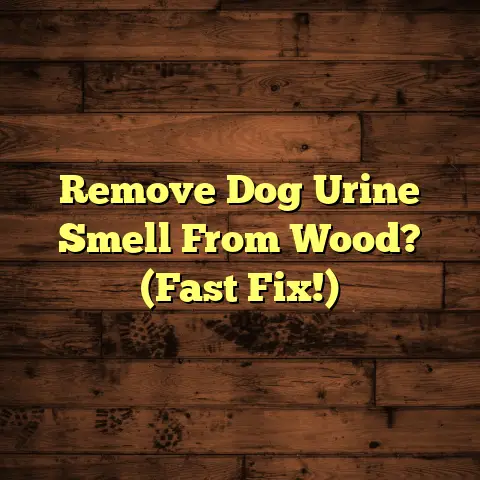Best Mold-Resistant Basement Paint? (6 Top Coats!)
Let me tell you, as a flooring contractor for over 20 years, I’ve seen my fair share of basement disasters. But nothing quite prepared me for the day I discovered mold blooming in my own basement. It wasn’t a massive infestation at first. Just a few dark spots near the floor after a particularly rainy season.
But that was enough to set off alarm bells. The musty smell was a dead giveaway, and the thought of what might be lurking behind the drywall sent shivers down my spine.
As a professional, I knew the risks. Respiratory issues, allergies, structural damage – the list goes on. I knew I had to act fast. That’s when I dove headfirst into researching the best ways to combat mold in basements.
And that’s how I stumbled upon mold-resistant paint. It seemed like a simple solution, but the more I researched, the more I realized how crucial it was to choose the right product.
So, after countless hours of research, testing, and talking to other pros, I’ve compiled my list of the best mold-resistant basement paints. I’m here to share my findings with you. I’m hoping to help you create a safe, healthy, and mold-free basement.
Section 1: Understanding Mold and Its Impact
Okay, let’s get down to the nitty-gritty. What exactly is mold?
Mold is a type of fungus that thrives in damp, dark, and poorly ventilated environments. Basements, with their tendency to trap moisture, are prime real estate for mold growth.
Think of it like this: mold spores are everywhere. They’re in the air we breathe. But they only become a problem when they find the right conditions to settle and multiply. That means moisture, organic material (like drywall or wood), and a comfortable temperature.
Now, why is mold such a big deal? Well, for starters, it’s not exactly a welcome guest in your home. But more importantly, it can pose serious health risks. According to the CDC, mold exposure can cause: * Respiratory issues: Coughing, wheezing, and shortness of breath.
-
Allergies: Sneezing, runny nose, itchy eyes, and skin rashes.
-
Asthma attacks: Mold can trigger asthma symptoms, especially in children. [[https://www.cdc.gov/mold/dampness_facts.html]]
But the health risks aren’t the only concern. Mold can also wreak havoc on your property. It can damage drywall, wood, carpets, and other materials, leading to costly repairs.
Plus, let’s be honest, a moldy basement isn’t exactly a selling point. It can significantly reduce your home’s value and make it harder to sell.
Section 2: The Importance of Mold-Resistant Paint
So, where does mold-resistant paint come into play? Think of it as your first line of defense against mold invasion.
Mold-resistant paints are specially formulated to inhibit mold growth. They contain antimicrobial agents that kill or prevent mold spores from taking hold. These paints create a protective barrier that repels moisture, preventing it from seeping into the walls.
But here’s the thing: mold-resistant paint isn’t a magic bullet. It won’t solve existing mold problems. If you already have mold, you need to address the source of the moisture and remove the mold before painting.
However, as a preventative measure, mold-resistant paint is invaluable. It helps to keep your basement dry and mold-free. Even if you have minor leaks or humidity issues.
Beyond mold prevention, these paints also offer other benefits. Many are easy to clean, durable, and resistant to stains. This makes them a practical choice for basements that see a lot of wear and tear.
Section 3: Key Features to Look for in Mold-Resistant Paint
Alright, so you’re convinced that mold-resistant paint is a good idea. But how do you choose the right one? Here are some key features to look for:
-
Antimicrobial properties: This is the most important factor. Make sure the paint contains EPA-registered antimicrobial agents that are effective against mold and mildew.
-
Breathability: A breathable paint allows moisture vapor to escape, preventing it from getting trapped behind the paint film. This is crucial in basements where moisture is a constant concern.
-
Low VOC (volatile organic compounds) content: VOCs are chemicals that can be harmful to your health. Choose a low-VOC paint to minimize indoor air pollution.
-
Water resistance: Look for paints that are specifically designed for damp environments. They will resist water penetration and prevent mold growth.
Here’s a quick table to summarize these features:
| Feature | Description |
|---|---|
| Antimicrobial Properties | Contains EPA-registered agents to kill/prevent mold. |
| Breathability | Allows moisture vapor to escape, preventing buildup. |
| Low VOC Content | Minimizes harmful chemical emissions. |
| Water Resistance | Resists water penetration, preventing mold growth. |
Section 4: Top 6 Mold-Resistant Basement Paints
Now for the moment you’ve been waiting for: my top 6 mold-resistant basement paints. I’ve personally used or researched each of these paints extensively, considering factors like performance, durability, and user reviews.
Paint 1: Rust-Oleum Mold Killing Primer
-
Description: This isn’t technically a paint, but a primer. And it’s a crucial first step in any mold-prevention project. Rust-Oleum Mold Killing Primer is designed to kill existing mold and mildew, and prevent future growth. It’s a water-based formula that’s easy to apply and dries quickly. It can be top-coated with any latex or oil-based paint.
-
Pros:
- Kills existing mold and prevents future growth.
- Excellent adhesion to various surfaces.
- Can be top-coated with any paint.
- Low odor.
-
Cons:
- It’s a primer, so you’ll need to apply a topcoat.
- More expensive than standard primers.
Paint 2: Kilz Mold & Mildew Interior/Exterior Paint
-
Description: Kilz is a well-known brand in the paint industry. Their Mold & Mildew Interior/Exterior Paint is a solid choice for basements. It’s a water-based paint that offers excellent mold and mildew resistance. It’s also scrubbable and durable, making it ideal for high-traffic areas.
-
Pros:
- Excellent mold and mildew resistance.
- Durable and scrubbable finish.
- Suitable for interior and exterior use.
- Good coverage.
-
Cons:
- May require multiple coats for optimal coverage.
- Some users report a slight odor during application.
Paint 3: Zinsser Mold Killing Interior Paint
-
Description: Similar to Rust-Oleum, Zinsser Mold Killing Interior Paint is designed to kill existing mold and prevent future growth. It’s a water-based paint that contains an EPA-registered antimicrobial agent. It’s also self-priming, which can save you time and money.
-
Pros:
- Kills existing mold and prevents future growth.
- Self-priming formula.
- Excellent adhesion.
- Low odor.
-
Cons:
- Can be more expensive than other mold-resistant paints.
- Limited color options.
Paint 4: Benjamin Moore Aura Bath & Spa Paint
-
Description: While not specifically marketed as a mold-resistant paint, Benjamin Moore Aura Bath & Spa Paint is an excellent choice for basements due to its exceptional moisture resistance. It’s a premium-quality paint that creates a durable, mildew-resistant finish. It’s also low-VOC and has a matte finish that hides imperfections.
-
Pros:
- Exceptional moisture resistance.
- Durable and long-lasting finish.
- Low-VOC formula.
- Excellent color retention.
-
Cons:
- More expensive than other mold-resistant paints.
- Requires proper surface preparation for optimal adhesion.
Paint 5: PPG PERMANIZER Exterior Acrylic Latex
-
Description: Don’t let the “exterior” in the name fool you. PPG Permanizer Exterior Acrylic Latex is a great option for basements due to its superior durability and mold resistance. It’s a 100% acrylic latex paint that provides excellent adhesion, coverage, and color retention. It’s also resistant to fading, cracking, and peeling.
-
Pros:
- Excellent durability and mold resistance.
- Superior adhesion and coverage.
- Resistant to fading, cracking, and peeling.
- Wide range of colors.
-
Cons:
- May have a slightly stronger odor than other low-VOC paints.
- Can be more expensive than standard latex paints.
Paint 6: Drylok White Extreme Waterproofer
-
Description: Drylok White Extreme Waterproofer is specifically designed to waterproof basement walls and prevent water from seeping through. It’s a thick, paint-like coating that creates a waterproof barrier. It also contains antimicrobial agents to inhibit mold and mildew growth.
-
Pros:
- Excellent waterproofing properties.
- Inhibits mold and mildew growth.
- Can be applied to bare concrete or masonry.
- Durable and long-lasting.
-
Cons:
- Can be difficult to apply due to its thick consistency.
- Limited color options.
- Requires proper surface preparation.
Section 5: Application Tips for Mold-Resistant Paint
Okay, you’ve chosen your paint. Now it’s time to get to work! But before you start slapping paint on the walls, it’s crucial to properly prepare the basement.
Here’s a step-by-step guide:
-
Cleaning and Repairing Walls:
- Start by removing any loose paint, dirt, or debris from the walls.
- Use a scraper or wire brush to remove any flaking paint.
- Wash the walls with a solution of TSP (trisodium phosphate) to remove any grease or grime.
- Rinse thoroughly with clean water and let dry completely.
- Repair any cracks or holes in the walls with patching compound.
- Sand smooth and prime before painting.
-
Addressing Moisture Issues Before Painting:
- This is the most important step.
- If you have any leaks or water intrusion, you need to fix them before painting.
- Identify the source of the moisture and take steps to eliminate it.
- This may involve repairing cracks in the foundation, improving drainage, or installing a dehumidifier.
-
Choosing the Right Tools and Equipment:
- You’ll need a good quality paint roller, paint brushes, paint tray, and painter’s tape.
- For larger areas, consider using a paint sprayer.
- Wear safety glasses and gloves to protect yourself from paint and chemicals.
Tips for Applying Mold-Resistant Paint:
-
Follow the manufacturer’s instructions: This is crucial for achieving the best results.
-
Apply two coats: Two coats of paint will provide better coverage and protection than one.
-
Allow the paint to dry completely between coats: This will ensure proper adhesion and prevent the paint from peeling.
-
Ventilate the basement: Open windows and doors to allow fresh air to circulate.
-
Use a dehumidifier: A dehumidifier can help to keep the basement dry and prevent mold growth.
Section 6: Maintenance and Longevity
Once you’ve painted your basement with mold-resistant paint, it’s important to maintain the surfaces to prevent mold from returning.
Here are some tips:
-
Regular Inspections: Inspect your basement regularly for signs of moisture or mold growth. Pay close attention to areas near the floor, windows, and pipes.
-
Cleaning Routines: Clean your basement walls and floors regularly with a mild detergent and water. Avoid using harsh chemicals or abrasive cleaners, as they can damage the paint.
-
Control Humidity: Keep the humidity level in your basement below 50%. Use a dehumidifier to remove excess moisture from the air.
-
Address Leaks Promptly: If you notice any leaks or water intrusion, address them immediately. Don’t wait until the problem gets worse.
-
Proper Ventilation: Ensure that your basement is properly ventilated. Open windows and doors whenever possible to allow fresh air to circulate.
Conclusion: Final Thoughts
Investing in mold-resistant basement paint is a proactive measure that can save you time, money, and headaches in the long run.
It’s not just about preventing mold growth; it’s about creating a safe, healthy, and comfortable living space for you and your family.
By choosing the right paint and following the application and maintenance tips outlined in this article, you can protect your home from the damaging effects of mold and enjoy the peace of mind that comes with a mold-free basement.
So, take action today and start protecting your home from mold. Your health and your home’s value will thank you for it!





